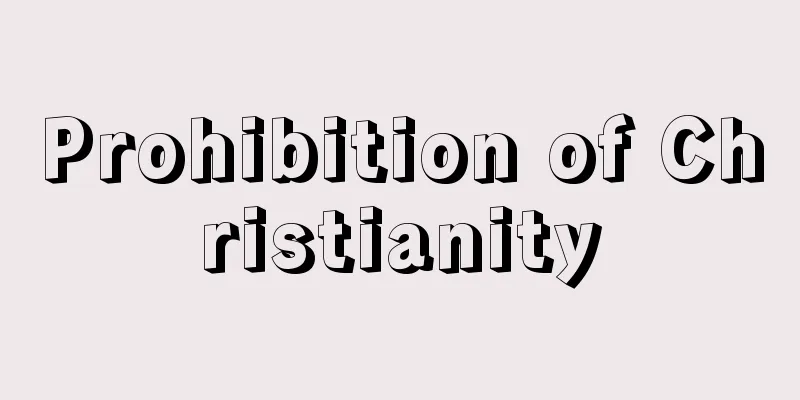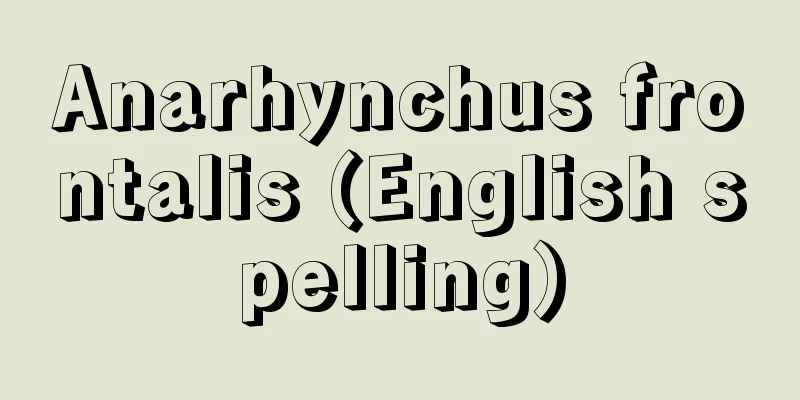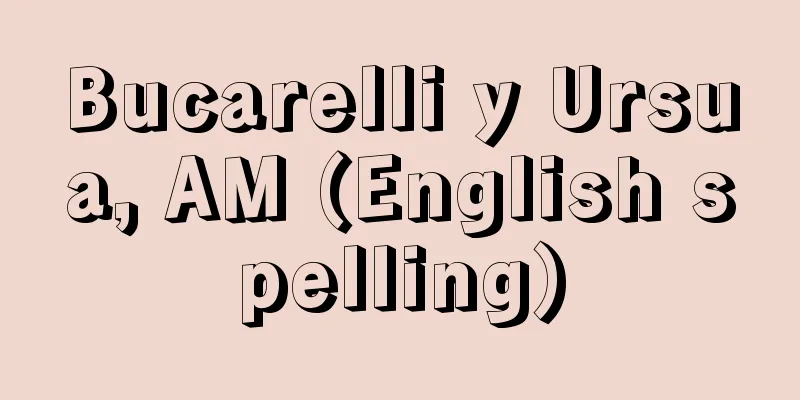Prohibition of Christianity

|
The Edo Shogunate's religious policy. One of the reasons for the "national isolation (maritime ban)," it was also an important measure to control the people by the Shogunate and feudal domain power, and it determined the foundation of order in early modern Japan, both externally and internally. Christianity, which was introduced to Japan by Francis Xavier in 1549 (Tenbun 18), was restricted by the Toyotomi government at the end of the 16th century, and was severely suppressed by the Edo Shogunate in the 17th century, resulting in many martyrs. Possible reasons for the ban include the threat of the military power of Portugal and Spain behind the missionaries, the collapse of the order that was based on oaths to gods and Buddhas, the doctrine of equality before God after death, regional domination based on Christians, the basis for armed uprisings and rebellions, and the dubious image of Christians wielding magic. None of these was the essential reason for the ban, and all of them are thought to have underpinned the logic of the ban throughout the early modern period, but the substance of the ban on Christianity and the weight of its logic changed with the changes in early modern society surrounding religion. For the Shogunate and feudal domain power, in the early 17th century, the threat to the military power of Portugal and Spain and to regional domination based on Christianity was of major importance, but after the Shimabara-Amakusa Rebellion (1637-1638, Kan'ei 14-15), in which peasants rose up in revolt with Christian ties, the emphasis shifted to armed uprisings and threats to the foundations of the rebellions. Later, as the real hidden Christians were buried in the secular order, the image of "Kirishitan" became poorer, and from the 18th century onwards, "Kirishitan" became increasingly confused with folk beliefs and the heretical religious activities of existing sects, creating a trend of labelling anything suspicious as "Kirishitan" and denouncement. This meant that the gradually amplified and suspicious image itself became the core of the logic behind the ban, and the substance of the ban on Christianity shifted from cracking down on the real hidden Christians who were obedient to the secular order to regulating heretical religious activities that deviated from the early modern order. The reason the hidden Christians were able to maintain their faith until the end of the Edo period was because the substance of the ban on Christianity changed along with their strong faith, and the ban on Christianity became unable to regulate the real hidden Christians. In fact, from the end of the 18th century onwards, in cases where the existence of hidden Christians was an issue, they were dealt with as "different sects" or "different laws" separate from "Kirishitan". However, regardless of whether or not a person was actually a Christian, if they were judged to be a "Kirishitan", they were still severely punished, so the fact that the substance of the ban on Christianity changed does not mean that it had relaxed. The ban on Christianity, which continued to restrict people in the early modern period through the religious reform system, which required people to be temple parishioners as proof that they were not Christians, became difficult to continue as the basis for maintaining secular order in the 19th century, and in its place the Meiji government launched a new religious policy. [Ohashi Yukiyasu] "Ohashi Yukiyasu, 'Research on the History of Christian People' (2001, Tokyodo Publishing)" ▽ "Ohashi Yukiyasu, 'Orthodoxy, Heresy, and Christianity - Maintaining Order in Early Modern Japan and the Prohibition of Christianity, Vol. 1 and 2'" (Waseda University Faculty of Education Academic Research, Geography, History, and Social Sciences, Vol. 54 and 55, 2006, 2007) Source: Shogakukan Encyclopedia Nipponica About Encyclopedia Nipponica Information | Legend |
|
江戸幕府の宗教政策。「鎖国(海禁)」の要因の一つで、幕藩権力による重要な民衆統制策でもあり、対外的にも対内的にも近世日本の秩序を根幹で規定した。1549年(天文18)フランシスコ・ザビエルにより日本に伝えられたキリシタンは、16世紀末豊臣政権によって規制が加えられたうえ、17世紀に入って江戸幕府により厳しく弾圧されたため、少なくない殉教者を出した。禁教の理由については、宣教師の背後にあるポルトガル・イスパニアの軍事力、神仏への宣誓で成り立っている秩序の崩壊、死後における神の前の平等という教義、キリシタンを基盤とした地域支配、武装蜂起・一揆の基盤、魔法を操るという怪しげなイメージ、などへの脅威が考えられる。このうちのどれかが禁教理由の本質というのではなく、どれもが近世期を通じて底流で禁教の論理を支えていたと思われるが、宗教を取り巻く近世社会の変容にともなって、キリシタン禁制の内実や禁教の論理の比重も変化していった。幕藩権力にとって、17世紀初期の段階では、ポルトガル・イスパニアの軍事力やキリシタンを基盤とした地域支配に対する脅威が大きな位置を占めていたが、キリシタンを紐帯に百姓が蜂起した島原・天草一揆(1637~1638年、寛永14~15)を経て武装蜂起や一揆の基盤への脅威にその重点が移った。その後、現実の潜伏キリシタンの世俗秩序への埋没にともなう「切支丹」イメージの貧困化によって、18世紀以降「切支丹」と、民間信仰や既存宗派の異端的な宗教活動との混同が進み、怪しげなものは何でも「切支丹」のレッテルを貼って糾弾するような風潮が生み出された。これは徐々に、増幅した怪しげなイメージこそが禁教の論理の中軸になっていったということを意味し、キリシタン禁制の内実は世俗秩序に従順な現実の潜伏キリシタンを取り締まるというよりも、近世秩序から逸脱する異端的宗教活動を規制するという方向へ転換したといえる。潜伏キリシタンが幕末までその信仰を維持できたのは、彼らの強靱な信仰心とともにキリシタン禁制の内実が変化したという背景があり、キリシタン禁制が現実の潜伏キリシタンを規制できなくなっていったからである。実際、18世紀末以降、潜伏キリシタンの存在が問題とされた事件では、「切支丹」とは別の「異宗」「異法」として処理された。ただし、実際にキリシタンだったかどうかは別として、「切支丹」と判断されれば厳罰に処されることには変わりなく、キリシタン禁制の内実が変化したというのはそれが弛んだという意味ではない。キリシタンでない証拠に寺院の檀那であることを求められる宗門改制度を通じて、近世人を拘束し続けたキリシタン禁制は、19世紀に入ると世俗秩序を維持する基軸であり続けることは困難となり、それに代わって明治政府による新たな宗教政策が立ち上がることになった。 [大橋幸泰] 『大橋幸泰著『キリシタン民衆史の研究』(2001・東京堂出版)』▽『大橋幸泰著「正統・異端・切支丹―近世日本の秩序維持とキリシタン禁制 上・下」(『早稲田大学教育学部 学術研究 地理学・歴史学・社会科学編54・55』所収・2006、2007)』 出典 小学館 日本大百科全書(ニッポニカ)日本大百科全書(ニッポニカ)について 情報 | 凡例 |
<<: Christian Books - Christian Books
Recommend
blok
…They also climb trees and sometimes rest on them...
Bukhara - Buhara (English spelling) Бухара/Buhara
The capital of Bukhara Oblast, Republic of Uzbeki...
Gravity - Inryoku
The force that attracts two objects to each other...
Northern Education
This magazine was first published in February 1930...
Ethnology
… [Anthropology and Ethnology] Although we may ta...
Cartesian
...The former is called synthetic geometry or pur...
Gibbons, G.
…The total length of the building is 515 feet (ab...
Naruto Strait
A strait between Shikoku and Awaji Island. It is ...
Wallace
British naturalist. From 1854 he studied the distr...
Henri Michaux
French poet and painter. Born in Belgium, he beca...
Gambling crime
Gambling, that is, the crime of gambling or being...
Coast Atlas [Mountain Range] - Coast Atlas
The Atlas Mountains are a series of small, low mo...
Stone saw - Ishinoko
A flat chipped stone tool with a sawtooth blade. S...
Balkan Romance (English spelling)
...In the case of languages that have developed...
Ivanov‐Razumnik
1878‐1946 Russian critic, thinker, and literary sc...









